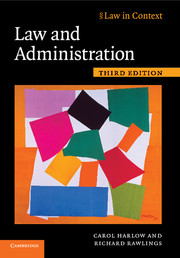Book contents
- Frontmatter
- Contents
- Preface
- Table of Cases
- Table of Statutes
- 1 Red and green light theories
- 2 The changing state
- 3 Transforming judicial review
- 4 Making the law
- 5 Rules and discretion
- 6 Regulation and governance
- 7 Regulatory design and accountability
- 8 Contractual revolution
- 9 Contract, contract, contract
- 10 Into the jungle: Complaints, grievances and disputes
- 11 Tribunals in transition
- 12 The Parliamentary Ombudsman: Firefighter or fire-watcher?
- 13 Inquiries: A costly placebo?
- 14 Continuity and change: Procedural review
- 15 Elite dimension: Court structures and process
- 16 Judicial review and administration: A tangled web
- 17 ‘Golden handshakes’: Liability and compensation
- Index
15 - Elite dimension: Court structures and process
Published online by Cambridge University Press: 05 June 2012
- Frontmatter
- Contents
- Preface
- Table of Cases
- Table of Statutes
- 1 Red and green light theories
- 2 The changing state
- 3 Transforming judicial review
- 4 Making the law
- 5 Rules and discretion
- 6 Regulation and governance
- 7 Regulatory design and accountability
- 8 Contractual revolution
- 9 Contract, contract, contract
- 10 Into the jungle: Complaints, grievances and disputes
- 11 Tribunals in transition
- 12 The Parliamentary Ombudsman: Firefighter or fire-watcher?
- 13 Inquiries: A costly placebo?
- 14 Continuity and change: Procedural review
- 15 Elite dimension: Court structures and process
- 16 Judicial review and administration: A tangled web
- 17 ‘Golden handshakes’: Liability and compensation
- Index
Summary
Although this book does not adopt the court-centred approach of many administrative lawyers, we have learned a good deal about judicial review in its pages. Consideration of the relationship between law and administration, and the contribution law can make to administration, bears directly on the question of the proper constitutional role of the courts. Intended to produce a more rounded picture of the part played by judicial review, the next chapters look to the dynamics, routings and effects of this form of litigation. This chapter focuses on major institutional developments over the last thirty years and on the procedural devices for rationing access to the system. Chapter 16 considers the make-up of the caseload, the workings of the judicial ‘tool-kit’ of remedies, and the cloudy issues of impact and compliance. What is the value of judicial review read — as the judges are naturally disposed to do — as the ‘apex’ of a pyramid of dispute resolution (see Chapters 10–11)? Is it, as de Smith thought, sporadic and peripheral? We shall discover that, conveniently obscured by the roll-call of leading cases, judicial review in England and Wales has a secret dimension; the expansion of parameters runs alongside a large-scale exclusion of people.
Models of judicial review
‘Judicial review’ is a slippery concept. Different constitutional systems show a wide range of possible arrangements — for example, constitutional review (United States), a dual jurisdiction (France) and systematised administrative appeals (Australia). As evidenced in the UK with equality and human rights, models of judicial review also change in line with societal values.
- Type
- Chapter
- Information
- Law and Administration , pp. 668 - 710Publisher: Cambridge University PressPrint publication year: 2009



